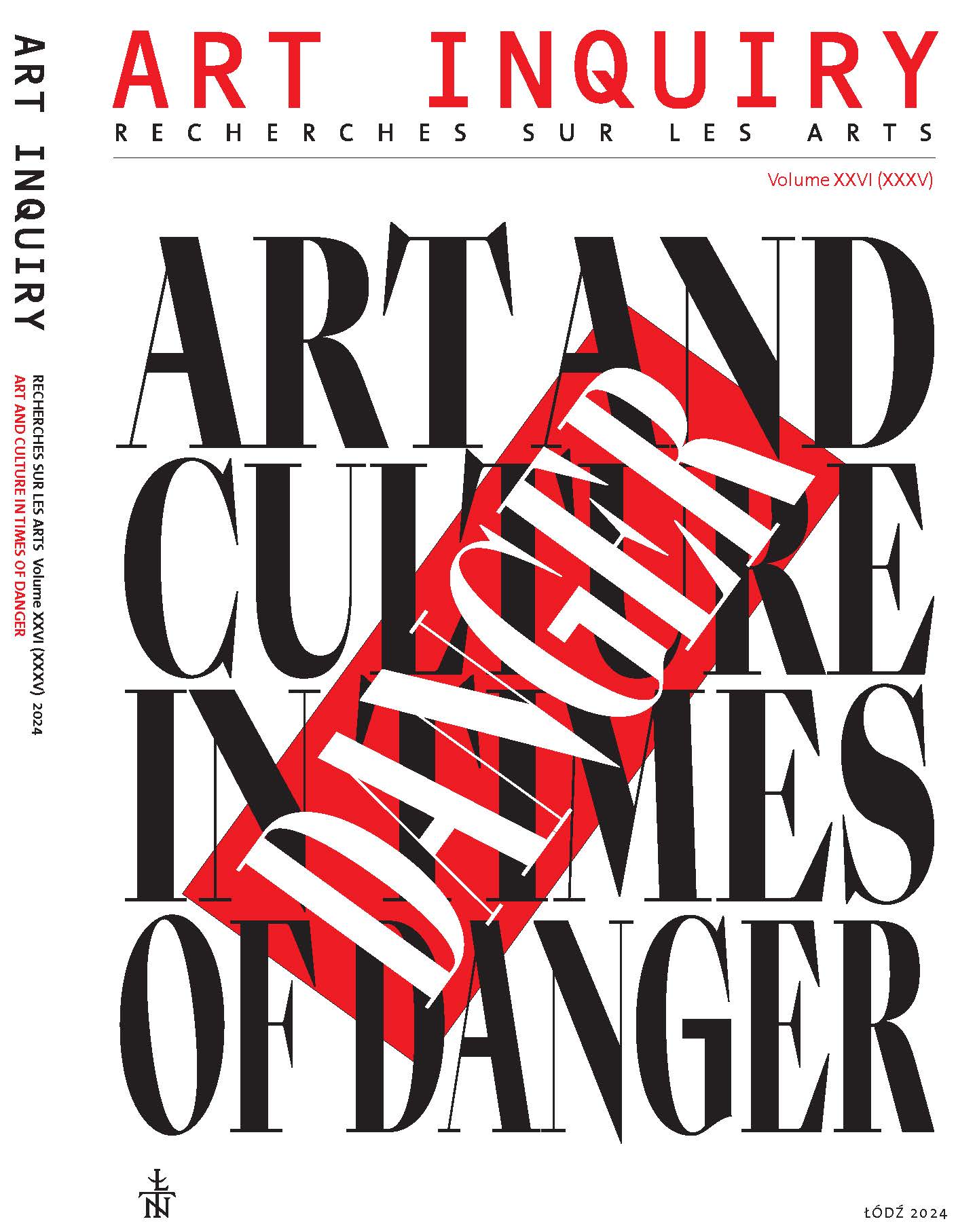Readymade: a problem for the definition of art. and its solution
DOI:
https://doi.org/10.26485/AI/2024/26/4Keywords:
the readymade, conceptual art, information art, evidentiality art, contextual art, anthropologized art, photography as art, photo-object, definition of artAbstract
Did Marcel Duchamp, by introducing the idea and practice of the readymade into art, solve the problem of a new way of defining art, or did he rather create a problem that we are struggling with to this day? The readymade has an ambivalent status both in the eyes of the creator himself and his contemporary critics, such as Pierre Cabanne, Robert Lebel and his later biographer, Calvin Tomkins. The artist did not identify with Dada and the Surrealistic sense of using the readymade. For Duchamp, the readymade is an idea to overcome the crisis of art after Cubism. The redymade became the essence of his new definition of art. A further result was the Conceptual Art of Joseph Kosuth and new media, photography and film as art, as described by Rosalind Krauss in her essays on indexical art. The basis for an exemplification of the theses of the article is a case study of Józef Robakowski's photo-object entitled Colander. The photograph here was pierced with a readymade nail. This gesture of the artist towards the image was embedded in the history of art of the modernist avant-gardes. In the article, the history of the readymade was compared with another parallel history of sociological art. This trend has been studied in George Grosz and Wieland Herzfeld's Art is in Danger, Contextual and Anthropologized Art, and contemporary curatorial narrative practices. The case study, Colander, shows a relationship between storytelling and the art form. Duchamp thus both solved and at the same time created a problem for defining art.
References
Białostocki Jan (1980) Historia sztuki wśród nauk humanistycznych, Wrocław: Ossolineum.
Bürger Peter (1984) Theory of the Avant-Garde, transl. from German by Michael Shaw, Manchester: Manchester University Press.
Cabanne Pierre (1979) Dialogs with Marcel Duchamp, transl. by Ron Padgett, Boston, MA, Da Capo Press, Inc.
[Duchamp Marcel], The Richard Mutt Case [1917] (1917) “The Blind Man,” 2 issue, eds. Marcel Duchamp with Beatrice Wood and Henri-Pierre Roché, New York: Henri Pierre Roché. https://monoskop.org/images/6/6f/The_Blind_Man_2_May_1917.pdf [accessed: 12.07.2024].
Duchamp Marcel, The Creative Act [1957], in: Michel Sanouillet, and Elmer Peterson, eds. (1973) The Writings of Marcel Duchamp, London: Thames and Hudson, pp. 138-140. https://monoskop.org/images/7/7c/Duchamp_Marcel_1957_1975_The_Creative_Act.pdf [accessed: 12.07.2024].
Duchamp Marcel, Apropos of “Readymades” [1966], in: Michel Sanouillet, and Elmer Peterson, eds. The Writings of Marcel Duchamp, London: Thames and Hudson 1973, pp. 141-142. https://monoskop.org/images/8/8e/Duchamp_Marcel_1961_1975_Apropos_of_Readymades.pdf. [accessed: 12.07.2024].
Elliott David, and Piotr Juszkiewicz (2003) "Socialist Realism", in: Grove Art Online, Oxford University Press. Doi:10.1093/gao/9781884446054.article.t079464 [accessed: 12.07.2024].
Grosz George, and Wieland Herzfelde (1971) Art is in Danger, in: Dadas on Art, ed. Lucy R. Lippard, Englewood Cliffs, NJ: Prentice-Hall, Inc., pp. 79-85.
Hughes Robert (Monday, Dec. 18, 1972) The Decline and Fall of the Avant-Garde, “Time”.https://content.time.com/time/subscriber/article/0,33009,945209-2,00.html [accessed: 12.07.2024].
Information (1970) ed. Kynaston L. McShine, New York: MoMA, Exh. cat. https://assets.moma.org/documents/moma_catalogue_2686_300337616.pdf [accessed: 12.07.2024].
Interview with Józef Robakowski, in: Józef Robakowski: Nearer-Farther (2017), interview by Hans Ulrich Obrist, ed. Bożena Czubak, Milano: Mousse Publishing, pp. 24-40.
Józef Robakowski. Istota Idei (2012), ed. Maria Szymańska-Korejwo, Gdańsk: Muzeum Narodowe w Gdańsku. Exhib. cat.
Józef Robakowski (2011), eds. Tobi Maler, and Michał Jachuła. Leipzig: Spector Books. Exh. cat. Toruńska grupa fotograficzna "Zero-61": przypomnienie (2001) Toruń: Wydawnictwo Uniwersytetu Mikołaja Kopernika. Exh. cat.
Józef Robakowski: Art is Power! (Breaking Photography), in: Józef Robakowski: Art is Power! Breaking Photography (2016), ed. Józef Robakowski, Łódź: Państwowa Wyższa Szkoła Filmowa, Telewizyjna i Teatralna im. L. Shillera w Łodzi [The Polish National Film, Television and Theater School in Lodz], pp. 11-17.
Kilroy Robert (2018) Marcel Duchamp’s Fountain: One Hundred Years Later, Cham: Palgrave Pivot.
Klein Julian (2010) What is artistic research? Academia.edu, https://www.academia.edu/9983441/What_is_artistic_research [accessed: 12.07.2024].
Kosuth Joseph (1993 (2002)) 1975, in: Joseph Kosuth, Art After Philosophy and After. Collected Writings, 1966-1990, ed. Gabriele Guercio, Cambridge, MA: MIT Press, pp. 129-143.
Kosuth Joseph (1993 (2002)) Within the Context: Modernism and Critical Practice, in: Joseph Art After Philosophy, in: Art After Philosophy and After. Collected Writings, 1966-1990, ed. Gabriele Guercio, Cambridge, MA: MIT Press, pp. 13-32.
Kosuth Joseph (1993 (2002)) Within the Context: Modernism and Critical Practice, in: Joseph Kosuth, Art After Philosophy and After. Collected Writings, 1966-1990, ed. Gabriele Guercio, Cambridge, MA: MIT Press, pp. 153-167.
Kosuth Joseph (1993 (2002)) Comments on the Second Frame, in: Joseph Kosuth, Art After Philosophy and After. Collected Writings, 1966-1990, ed. Gabriele Guercio, Cambridge, MA: MIT Press, pp. 169-173.
Kosuth Joseph (1993 (2002)) Text/Context: Seven Remarks for You to Consider while Viewing/Reading this Exhibition, in: Joseph Kosuth, Art After Philosophy and After. Collected Writings, 1966-1990, ed. Gabriele Guercio, Cambridge, MA: MIT Press, pp. 179-182.
Kosuth Joseph (1993 (2002)) No Exit, in: Joseph Kosuth, Art After Philosophy and After. Collected Writings, 1966-1990, ed. Gabriele Guercio, Cambridge, MA: MIT Press, pp. 227-234.
Kosuth, Joseph (1993 (2002)) The Artist as Anthropologist, in: Art After Philosophy and After. Collected Writings, 1966-1990, ed. Gabriele Guercio, Cambridge, MA: MIT Press, pp. 107-128.
Krauss Rosalind E. (Spring 1977) Notes on the Index: Seventies Art in America. Part 1, “October”, vol. 3, pp. 68-81.
Krauss Rosalind E. (Autumn 1977) Notes on the Index: Seventies Art in America. Part 2, “October”, vol. 4, pp. 58-67.
Lebel Robert (1959) Marcel Duchamp, translated by George Heard Hamilton, New York: Grove Press.
Morawski Stefan (1989) On the Avant-garde, Neo-avant-garde and the Case of Postmodernism, “Literary Studies in Poland”, no. 21, pp. 81-106.
Sanouillet Michel, and Elmer Peterson, eds. (1973) The Writings of Marcel Duchamp, London: Thames and Hudson. https://monoskop.org/images/a/a9/Duchamp_Marcel_The_Essential_Writings_of_Marcel_Duchamp.pdf.
Świdziński Jan (1978) Art as Contextual Art, Warszawa: Galeria Remont.
Tomkins Calvin (1966) The World of Marcel Duchamp 1887-1968, New York: Time Life Books.
Zonnenberg Nathalie (2019) Conceptual Art in a Curatorial Perspective, Between Dematerialization and Documentation, Amsterdam: Valiz.
Downloads
Published
Issue
Section
License
Copyright (c) 2024 Łódzkie Towarzystwo Naukowe

This work is licensed under a Creative Commons Attribution 4.0 International License.



